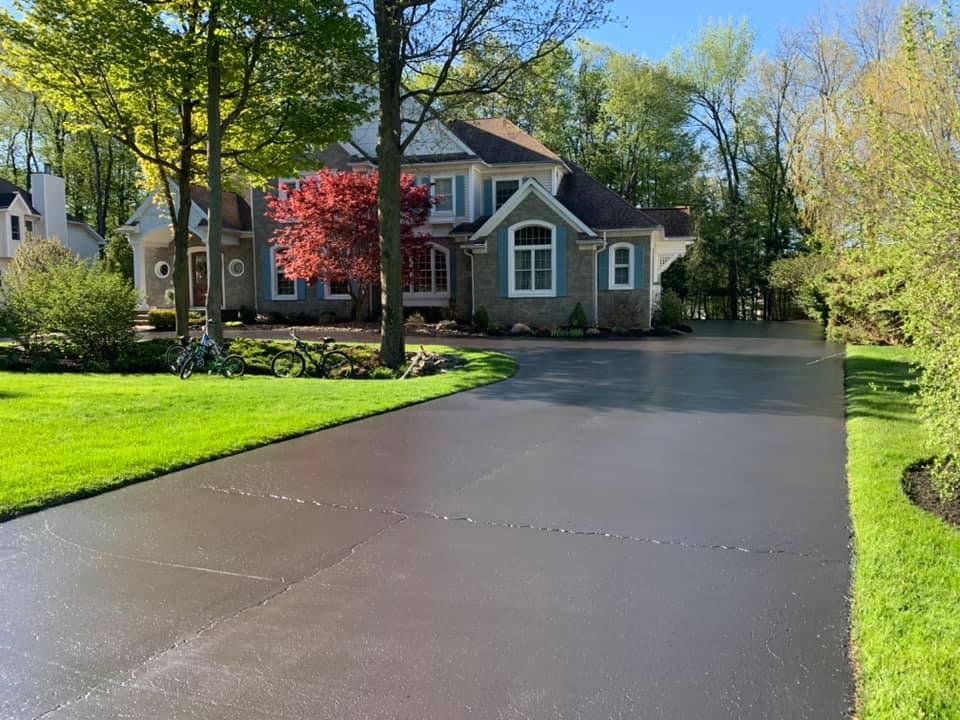Unlock the Keys of Asphalt Sealing: Making Best Use Of Hot Mix Asphalt Longevity
Unlock the Keys of Asphalt Sealing: Making Best Use Of Hot Mix Asphalt Longevity
Blog Article
Warm Mix Asphalt: A Lasting Option for Sidewalk
Warm Mix Asphalt (HMA) has become a leading sustainable option for pavement remedies, using a myriad of ecological benefits and ingenious innovations. Its capacity to reduce and recycle products energy usage presents an engaging situation for its adoption in road building and construction tasks. Additionally, the long-lasting performance and sturdiness of HMA make it a recommended choice for facilities advancement. As the demand for green building methods grows, discovering the subtleties of HMA's sustainability can offer valuable understandings into the future of sidewalk options.
Environmental Advantages of Warm Mix Asphalt

Furthermore, Hot Mix Asphalt helps to mitigate urban warm island results. Its dark shade takes in sunshine, reducing the amount of heat reflected back into the atmosphere contrasted to lighter-colored pavements. This can decrease ambient temperatures in metropolitan areas, reducing the need for air conditioning and ultimately lowering power usage.
In enhancement, Warm Mix Asphalt adds to boosted stormwater management. Its permeable nature enables water to infiltrate the sidewalk and recharge groundwater products, decreasing drainage and the threat of flooding. These ecological advantages make Warm Mix Asphalt a sustainable selection for paving highways and roadways.
Power Efficiency in HMA Production
Is power performance an important aspect in the production of Hot Mix Asphalt (HMA)? Power plays a considerable role in the manufacturing of HMA, impacting both cost and environmental sustainability. One key aspect of power effectiveness in HMA production is the use of warm mix asphalt (WMA) technologies.
Moreover, advancements in plant innovations have led to even more energy-efficient HMA production processes. By optimizing energy usage in HMA manufacturing, the sector can minimize its carbon footprint while keeping top quality pavement products.
Recyclability of Warm Mix Asphalt
The recyclability of Hot Mix Asphalt (HMA) is a pivotal facet of its sustainability and long-term ecological effect. HMA is one of one of the most recycled products in the United States, with over 100 million lots of recovered asphalt sidewalk (RAP) being recycled yearly in brand-new sidewalk building. Reusing HMA offers numerous environmental advantages, such as minimizing the requirement for virgin materials, lowering energy usage throughout production, and decreasing the amount of waste sent out to landfills.
The process of recycling HMA includes crushing the existing pavement, crushing it right into smaller sized pieces, and mixing it with brand-new accumulation and asphalt binder to produce a recycled mix. In general, the recyclability of HMA plays a substantial duty in advertising lasting methods within the pavement sector.

Long-Term Efficiency of HMA
Asphalt sidewalks show sturdiness and strength over an extended period, mirroring the lasting efficiency of Hot Mix Asphalt (HMA) The long life of HMA can be credited to its capacity to stand up to heavy traffic loads, extreme climate condition, and the effects of aging. Studies have revealed that properly designed and correctly constructed HMA pavements can last for twenty years or more with routine maintenance. The trick to making best use of the lasting performance of HMA lies click here for info in utilizing high-grade products, complying with best techniques in building, and implementing reliable maintenance techniques. Appropriate drain, regular inspections, and timely repair work are important for maintaining the architectural stability of HMA pavements with time. Furthermore, developments in HMA technology, such as the usage of polymer-modified binders and warm mix asphalt, have better improved the sturdiness and longevity of HMA pavements. By focusing on quality browse around these guys construction and upkeep techniques, HMA remains to prove itself as a lasting and affordable option for long-lasting sidewalk infrastructure.

HMA: Sturdiness and Sustainability
Showing both toughness and sustainability, Warm Mix Asphalt (HMA) has ended up being a keystone in the building and construction of long-lasting sidewalk infrastructures - regrading. HMA's toughness originates from its ability to endure hefty loads, harsh weather, and high traffic quantities, making it a reliable choice for streets, freeways, and airport terminal runways. The structure of HMA, which generally includes accumulations, binder, and filler, plays a critical role in enhancing its longevity and resistance to tear and wear
Additionally, HMA's sustainability depends on its recyclability and energy-efficient manufacturing procedure. The capability to reuse recovered asphalt pavement (RAP) in new HMA mixtures decreases the demand for virgin materials and decreases the environmental effect of sidewalk construction and maintenance. Furthermore, the power performance of producing HMA depends on its lower blending temperatures contrasted to various other pavement materials, bring about reduced energy usage and greenhouse gas exhausts.
Final Thought
In conclusion, warm mix asphalt (HMA) provides a sustainable remedy for sidewalk with its eco pleasant characteristics. HMA's recyclability, power effectiveness in manufacturing, and long-lasting sturdiness read the article make it an eco-friendly option for road building and construction.
HMA is one of the most recycled materials in the United States, with over 100 million heaps of redeemed asphalt pavement (RAP) being recycled each year in brand-new sidewalk construction.The process of reusing HMA involves grating the existing sidewalk, crushing it right into smaller sized pieces, and blending it with new aggregate and asphalt binder to create a recycled mix.Asphalt sidewalks demonstrate durability and resilience over an extended duration, reflecting the lasting performance of Warm Mix Asphalt (HMA) Additionally, innovations in HMA technology, such as the usage of polymer-modified binders and cozy mix asphalt, have actually additionally enhanced the toughness and longevity of HMA pavements. The capacity to reuse recovered asphalt pavement (RAP) in new HMA combinations decreases the need for virgin materials and decreases the ecological influence of pavement building and upkeep.
Report this page